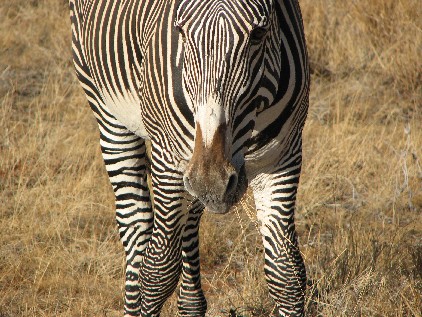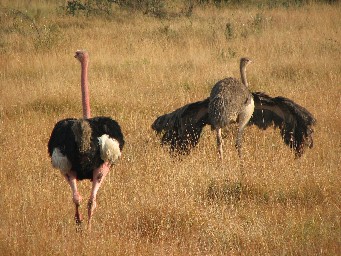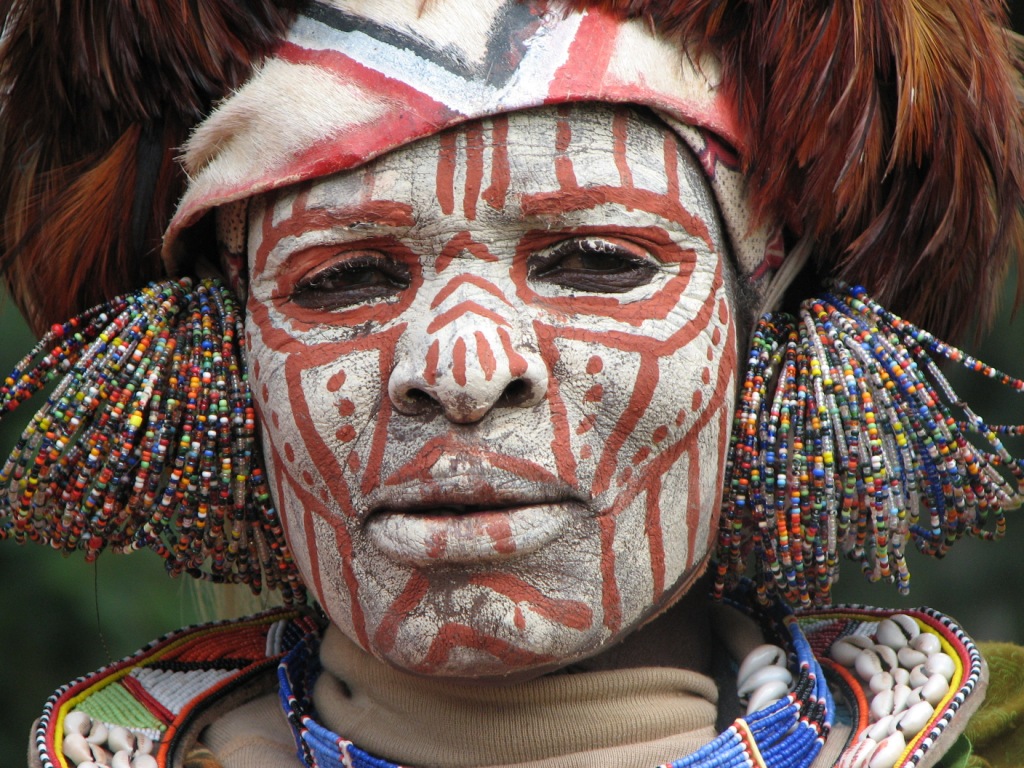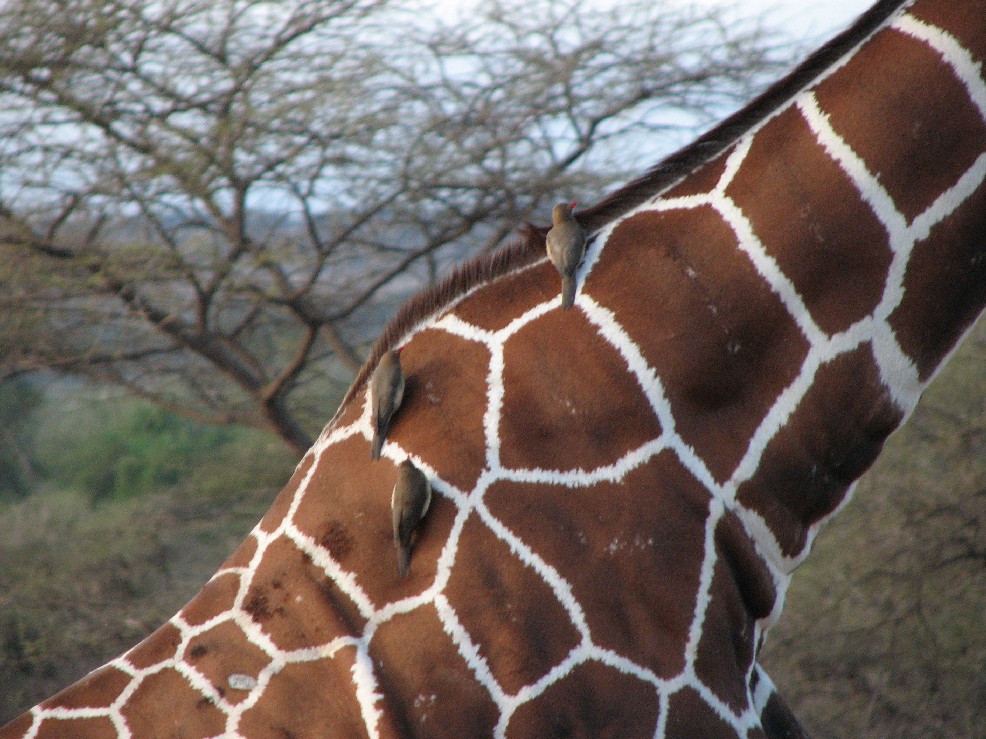So Samburu National Park is found in the northern Kenya and as such is a bit different in terms of flora and fauna (although we aren't talking about falling through the looking glass here Alice) and particularly has different varieties of ostrich, zebra, giraffe and some plants and birds. The park is part of a larger area of  reserves which is around 300 sq kilometers nestled around the Ewaso Ngiro River and home of the Samburu peoples. The environment approaching the park is some of the driest and harshest I had seen in Kenya (although continue further north and I would take that back). We seemed to literally be driving in the middle of nowhere and all the sudden the pastoralist landscape, full of cows and goats further south, changes to cows and camels! Seeing that we were in the middle of nowhere and I had an urge to water a plant we stopped and I ran for the bushes, several kilometers away from the park entrance. All the guys (I was the only woman at the time on this safari) when for another thorn bush. I immediately noticed two things, (1) it is extremely dusty and everything here has thorns and (2) there are several large camels watching me with interest. We thought we were alone and out of nowhere....children are rushing from the other side of the road. This is one of those moments that I wish my pluming did not require my bare butt to choose....flash the camels or the kids! Really they didn't get that close and I immediately noticed another difference in the northern areas as the children caught up with the relieved passengers returning to the van: the children said..."Give me water!" instead of "Give me pens!" That is a pretty hard request to deny but we were unprepared and could not provide hydration even if we wanted to. A local in the park assured me that the situation wasn't as dire as it looked. The Samburu people have been living in this arid climate for hundreds of years, those kids should drink cattle milk and blood like all the other pastoralist. He added that was probably the only English they knew and they probably didn't know what they were saying. Okay, although it still seems hard to deny someone water?
reserves which is around 300 sq kilometers nestled around the Ewaso Ngiro River and home of the Samburu peoples. The environment approaching the park is some of the driest and harshest I had seen in Kenya (although continue further north and I would take that back). We seemed to literally be driving in the middle of nowhere and all the sudden the pastoralist landscape, full of cows and goats further south, changes to cows and camels! Seeing that we were in the middle of nowhere and I had an urge to water a plant we stopped and I ran for the bushes, several kilometers away from the park entrance. All the guys (I was the only woman at the time on this safari) when for another thorn bush. I immediately noticed two things, (1) it is extremely dusty and everything here has thorns and (2) there are several large camels watching me with interest. We thought we were alone and out of nowhere....children are rushing from the other side of the road. This is one of those moments that I wish my pluming did not require my bare butt to choose....flash the camels or the kids! Really they didn't get that close and I immediately noticed another difference in the northern areas as the children caught up with the relieved passengers returning to the van: the children said..."Give me water!" instead of "Give me pens!" That is a pretty hard request to deny but we were unprepared and could not provide hydration even if we wanted to. A local in the park assured me that the situation wasn't as dire as it looked. The Samburu people have been living in this arid climate for hundreds of years, those kids should drink cattle milk and blood like all the other pastoralist. He added that was probably the only English they knew and they probably didn't know what they were saying. Okay, although it still seems hard to deny someone water?
 We arrived relatively late in the park and began to proceed to the camp before we get there we see a group of elephants, mostly juveniles in the foreground of the Ewaso Ngiro River. These elephants, which are a prominent feature in many Kenyan parks, are a bit more sophisticated than their southern relatives. Due to pressures from poaching, which claimed the lives of 25 elephants in early 2002, the organization Save the Elephants (http://www.savetheelephants.com/) has provided mobile phones to the elephants of Samburu National Reserve! (Okay now I do feel like the last person on earth without a mobile) The program, utilizing cellular technology through the use of a GSM collar, have set up a system by which each elephant automatically "sends" a text message every hour to a scientist phone. This means that the elephants are tracked in "real time" which is a ground breaking method of studying animal migrations and movements. This can ultimately help scientist answer important questions relating to habitat requirements and preferences, especially in regards to designing and designating protective corridors which allow movement between larger spaces of protected areas. Ain't technology nifty!
We arrived relatively late in the park and began to proceed to the camp before we get there we see a group of elephants, mostly juveniles in the foreground of the Ewaso Ngiro River. These elephants, which are a prominent feature in many Kenyan parks, are a bit more sophisticated than their southern relatives. Due to pressures from poaching, which claimed the lives of 25 elephants in early 2002, the organization Save the Elephants (http://www.savetheelephants.com/) has provided mobile phones to the elephants of Samburu National Reserve! (Okay now I do feel like the last person on earth without a mobile) The program, utilizing cellular technology through the use of a GSM collar, have set up a system by which each elephant automatically "sends" a text message every hour to a scientist phone. This means that the elephants are tracked in "real time" which is a ground breaking method of studying animal migrations and movements. This can ultimately help scientist answer important questions relating to habitat requirements and preferences, especially in regards to designing and designating protective corridors which allow movement between larger spaces of protected areas. Ain't technology nifty! commonly seen animals on the southern safari root and a few others that aren't so prominent in the south. The Grevy's zebra (Equus grevyi) is the largest zebra in the zebra family, who also has noticeably larger ears (almost a mule like face), a white belly and narrow black stripes. They are often found in association with the Beisa Oryx (Oryx gazella beisa) which is one "sick" looking antelope (for those of you that don't know, "sick" is apparently a good thing now). The oryx has a pair of horns that almost seem counter-productive as they are so long that you can't imagine how they could lower their heads enough to impale something. However they are not simply a spirited ornament, and if fleeing fails, they can inflict serious or fatal injuries on would be attackers.
commonly seen animals on the southern safari root and a few others that aren't so prominent in the south. The Grevy's zebra (Equus grevyi) is the largest zebra in the zebra family, who also has noticeably larger ears (almost a mule like face), a white belly and narrow black stripes. They are often found in association with the Beisa Oryx (Oryx gazella beisa) which is one "sick" looking antelope (for those of you that don't know, "sick" is apparently a good thing now). The oryx has a pair of horns that almost seem counter-productive as they are so long that you can't imagine how they could lower their heads enough to impale something. However they are not simply a spirited ornament, and if fleeing fails, they can inflict serious or fatal injuries on would be attackers. Another variation within Samburu's arid expanses is the Reticulated Giraffe (Giraffa camelopardalis reticulata), which is a particularly handsome subspecies of the Masai Giraffe described in our guide as having a "striking coat" with crisp lines that produce a "crazy pavement" appearance (see photograph "Hitching a Ride" on the right column of the blog). They are quite beautiful and visually distinct from the other two varieties. Unfortunately we did not get to see the subspecies of ostrich, the Somali Ostrich, which as the name indicates is a northeastern variety found in Somalia, Ethiopia and northern Kenya. Although that couldn't get me down, as we got several glimpses of the innovative gazelle called the Gerenuk (Litocranius walleri), which has a slender, elongated neck and often forages standing up on its hind legs! We also got our first glimpse of a leopard in Samburu National Reserve, which involved unfortunate incidence of nearly 50 vehicles crowded around a small shrub, pushing, yelling and getting quite rude with each other, as the large cat slumbered nearby. The leopard would occasionally rise, turn around in a circle (very similar to a domestic house cat) and lay back down, sending the frenzy of cameras, budget and luxury vehicles in to frenzy for a glimpse. It was obnoxious and I soon started behaving as a child myself... "Can we go yet?"
Another variation within Samburu's arid expanses is the Reticulated Giraffe (Giraffa camelopardalis reticulata), which is a particularly handsome subspecies of the Masai Giraffe described in our guide as having a "striking coat" with crisp lines that produce a "crazy pavement" appearance (see photograph "Hitching a Ride" on the right column of the blog). They are quite beautiful and visually distinct from the other two varieties. Unfortunately we did not get to see the subspecies of ostrich, the Somali Ostrich, which as the name indicates is a northeastern variety found in Somalia, Ethiopia and northern Kenya. Although that couldn't get me down, as we got several glimpses of the innovative gazelle called the Gerenuk (Litocranius walleri), which has a slender, elongated neck and often forages standing up on its hind legs! We also got our first glimpse of a leopard in Samburu National Reserve, which involved unfortunate incidence of nearly 50 vehicles crowded around a small shrub, pushing, yelling and getting quite rude with each other, as the large cat slumbered nearby. The leopard would occasionally rise, turn around in a circle (very similar to a domestic house cat) and lay back down, sending the frenzy of cameras, budget and luxury vehicles in to frenzy for a glimpse. It was obnoxious and I soon started behaving as a child myself... "Can we go yet?" 
(Two Gerenuks browsing in the trees.)

("I spy" a leopard that wants all those annoying vans to go away!)
 We also saw cheetahs again in this park, although this time (unlike the leopard) they were hastily moving along the contour of the scrub land and truly struck me how beautiful and dramatic they really are. When moving, the camouflage becomes apparent as they deceive even the primate eye, on occasion, blending with the golden-grasses of the scrub-savanna. I was truly able to appreciate them in this environment and in this situation in which they weren't corralled in by safari vans.
We also saw cheetahs again in this park, although this time (unlike the leopard) they were hastily moving along the contour of the scrub land and truly struck me how beautiful and dramatic they really are. When moving, the camouflage becomes apparent as they deceive even the primate eye, on occasion, blending with the golden-grasses of the scrub-savanna. I was truly able to appreciate them in this environment and in this situation in which they weren't corralled in by safari vans. s well as doum palm
s well as doum palm sprinkled river shores. It was worth the long and rough ride and even the camel-laden toilet "facilities."
sprinkled river shores. It was worth the long and rough ride and even the camel-laden toilet "facilities."













No comments:
Post a Comment